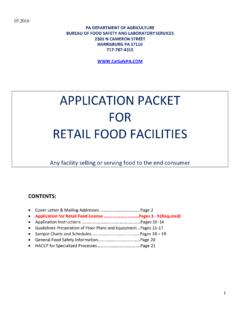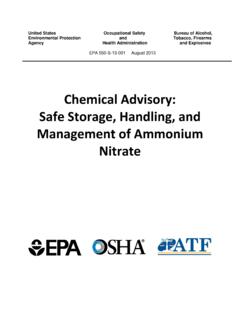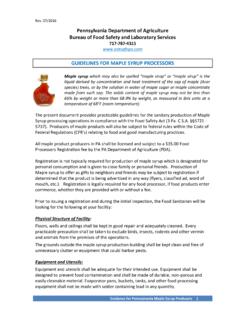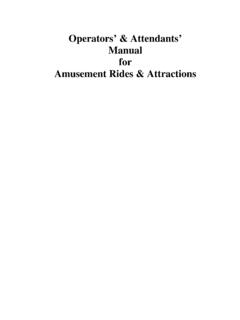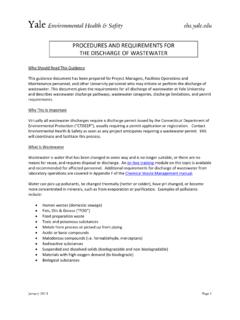Transcription of Good Manufacturing Practices Checklist
1 Current Good Manufacturing Practices (GMPs) -- food Establishment Checklist * -- * This document serves as a guide only. The official regulations can be found in 21 CFR Part 117 which can be accessible at: PERSONNEL Qualification & Training Yes/No/NA 1. (a) Did you ensure that all individuals engaged in Manufacturing , processing, packing, or holding food are qualified to perform their assigned duties? 2. (c) Did you ensure that supervisory personnel have the education, training, or experience (or a combination thereof) necessary to supervise the production of clean and safe food ? 3. (b) Did you train employees in the principles of food hygiene and food safety? 4. (d) Do you have and maintain records documenting training of qualified individuals? 5. Do your training records meet general record requirements (facility name/address, trainer sign/date, accurate, legible, etc.)
2 ? 6. Did you retain training records for at least 2 years after they were prepared? PERSONNEL Employee Health & Hygienic Practices Yes/No/NA 7. (a) Does management take all reasonable measures and precautions to ensure disease control by excluding employees who by supervisory observation or medical examination appear to be ill or have open lesions or other abnormal source of microbial contamination? 8. (a) Are employees instructed to report health conditions that might contaminate food , food product surfaces or food packaging materials to their supervisor? 9. (b)(1) Do employees protect against contamination of food and allergen cross-contact by properly wearing suitable outer garments, hair nets, beard coverings, 10. (b)(2) Do employees maintain adequate personal cleanliness? 11. (b)(3) Do employees wash hands thoroughly before work and after each absence from their work station?
3 12. (b)(4) Do employees remove unsecured jewelry and other objects that might fall into food ? 13. (b)(5) Are gloves used for food handling made of an impermeable material and maintained in a clean sanitary condition? 14. (b)(6) Do employees properly wear effective hair restraints (hair and beard covers, etc.)? 15. (b)(7) Do employees store clothing or other personal belongings away from areas where food is exposed or where equipment or utensils are washed? 16. (b)(8) Do employees confine eating, drinking, gum chewing, and use of tobacco to areas where food is not exposed or equipment and utensils are not washed? 17. (b)(9) Do employees protect against allergen cross-contact and against contamination with microorganisms or other foreign substances such as perspiration, cosmetics, medicines, FACILITY & GROUNDS Yes/No/NA 18. (a) Are the grounds about your plant under your control kept in a condition that will protect against the contamination of food ?
4 19. (a)(1) Are areas within the vicinity of the plant kept free from litter and waste with grass and weeds trimmed? 20. (a)(2) Are roads, yards and parking lots maintained to prevent sources of contamination? 21. (a)(3) Is there adequate drainage of outside areas that may contribute to contamination? 22. (a)(4) Are systems for waste treatment and disposal operated in a manner to protect against contamination? 23. (a)(5) Are steps taken to prevent potential sources of food contamination where bordering grounds not under the control of the facility are not maintained? 24. (b) Are the plant buildings and structures of suitable size, construction , and design to maintain sanitary operations and to produce safe food ? 25. (b)(1) Does the plant building(s) provide sufficient space for placement of equipment and storage of materials to permit maintenance of sanitary operations and production of safe food ?
5 Current Good Manufacturing Practices (GMPs) -- food Establishment Checklist * -- * This document serves as a guide only. The official regulations can be found in 21 CFR Part 117 which can be accessible at: FACILITY & GROUNDS (cont.) Yes/No/NA 26. (b)(2) Are food processing areas effectively separated ( location, time, partition, etc.) from other operations which may cause contamination of food being processed or allergen cross-contact? 27. (b)(3) Are there proper precautions to protect food in outdoor bulk vessels? 28. (b)(4) Are floors, walls and ceilings constructed to facilitate adequate cleaning and repair? 29. (b)(4) Does drip or condensate from fixtures, ducts and pipes cause or potentially cause contamination of food , food contact surfaces or food packaging materials? 30. (b)(4) Are aisles and working spaces unobstructed and of adequate width to permit employees to perform their jobs and protect against contamination of food by clothing or personal contact?
6 31. (b)(5) Is there adequate lighting in all hand-washing and toilet areas, and dressing and locker rooms? 32. (b)(5) Is there adequate lighting in all areas where food is processed, packed, or stored and where utensils and equipment are cleaned? 33. (b)(5) Are food products and processing areas protected against contamination from breakage of light bulbs and other glass fixtures? 34. (b)(6) Is air quality and ventilation or other control systems adequate to prevent contamination by dust, odors, vapors (including steam and noxious fumes) and/or other airborne substances? 35. (b)(6) Are fans and other air blowing equipment located in a manner to prevent allergen cross-contact and contamination of food , food contact surfaces and food packaging materials? 36. (b)(7) Are doors, windows and other openings protected by adequate screening or other protection to eliminate entry by insects, rodents and other pests?
7 sanitary OPERATIONS Yes/No/NA 37. (a) Are buildings, physical facilities, fixtures, etc. kept clean and in a good state of repair? 38. (a) Are cleaning and sanitizing of utensils and equipment performed in a manner to protect against contamination and allergen cross-contact? 39. (c)(1) Are equipment and utensils properly cleaned and sanitized and, as necessary, equipment are taken apart for thorough cleaning? 40. (b)(1) Are cleaning compounds and sanitizing agents free from microorganisms and used in a safe and effective matter? 41. (b)(2) Are cleaning compounds, sanitizing agents, pesticide chemicals and other hazardous materials identified, kept in original containers and stored separate from raw materials? 42. (c) Are the processing areas maintained free of insects, rodents, and other pests? 43. (c) Are effective measures taken to exclude pests from processing areas? 44.
8 (c) Are insecticides and rodenticides used and stored so as to prevent contamination of food , food contact surfaces and food -packaging material? 45. (d) Are all utensils and equipment food -contact surfaces cleaned and sanitized at intervals frequently enough to protect against allergen cross-contact and contamination of food ? 46. (d)(1) Are food -contact surfaces used for Manufacturing or holding low-moisture food dry and in a sanitary condition at the time of use? 47. (d)(2) In wet processing, are food contact surfaces cleaned and sanitized before use and after any interruption during which contamination could occur? 48. (d)(3) Are single-service articles (paper cups, towels, etc.) stored, handled, dispensed, used and disposed of in an appropriate manner? 49. (e) Are non- food -contact surfaces of equipment cleaned at intervals frequently enough to protect against allergen cross-contact and contamination of food , food contact surfaces and food -packaging materials?
9 50. (f) Are cleaned and sanitized portable equipment with food -contact surfaces and utensils stored in a manner that protects them from contamination ( splash, dust, etc.)? Current Good Manufacturing Practices (GMPs) -- food Establishment Checklist * -- * This document serves as a guide only. The official regulations can be found in 21 CFR Part 117 which can be accessible at: sanitary FACILITIES & CONTROLS Yes/No/NA 51. (a) & (b)(1) Is the facility's water supply from approved source and of adequate quantity and quality for its intended uses? 52. (a) Are the water temperature and pressure maintained at suitable levels for intended use? 53. (b) Is the plumbing adequately sized, designed, installed and maintained in a manner to prevent contamination? 54. (c) Is the sewage disposal system adequate? 55. (d) Are adequate toilet facilities provided, equipped and maintained clean and in good repair?
10 56. (e) Are adequate hand-washing facilities provided where appropriate (convenient, equipped, running water at a suitable temperature, etc.)? 57. (f) Is all refuse properly conveyed, stored, protected where necessary from pests and disposed of in an adequate manner? EQUIPMENT & UTENSILS Yes/No/NA 58. (a)(1) Are all plant equipment and utensils designed to be adequately cleanable and properly maintained? 59. (a)(2) Is equipment designed and used in a manner that precludes contamination with lubricants, fuel, contaminated water, metal fragments, and other contaminants? 60. (a)(3) Is equipment installed and maintained so as to facilitate the cleaning of equipment and adjacent areas? 61. (a)(4) and (5) Are food -contact surfaces of equipment made of corrosion-resistant, non-toxic and durable material? 62. (a)(6) Are food -contact surfaces and utensils properly maintained to protect food ?
